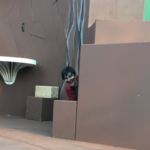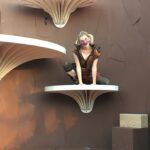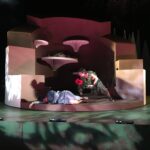By Kalina Ko, Literary Intern
1. The start of the process

The decision to stage A Midsummer Night’s Dream was made in September, 2017, nearly a year before the first performance. San Francisco Shakespeare’s artistic director and the director for this play, Rebecca J. Ennals, wanted to create a production that was accessible for people from all ages and all levels of Shakespeare experience:
“I’m going to really try and make this a production that people who are seeing Midsummer for the first time can see and totally get. It’s not going to be too clever for them. It’s not going to be too concept-y for them. It’s going to be the play that they might imagine if they were to pick up the play and read it.”
Embracing the magic and the fairy world of the show was also important for her. This magical world tends to attract children, creating a more family-friendly show.
“What are the fairies and what is their magic? How are they all around us? One of my favorite moments in the production is when the lovers are fighting and then these little fairies are hanging out watching them and there’s a lot of them, not just Puck and Oberon, but there’s a bunch of other fairies watching too and it’s just the idea that these little invisible beings might be places and as a kid I loved that idea.”
After the decision was made, the next step was to find designers and to cast actors.
2. The design
What would a show be without the magnificent set, costumes, sound, lights, props, and masks brought to us by our designers? Our production of A Midsummer Night’s Dream features a spinning set, nearly 20 different masks, elaborate costumes, original music, and dazzling lights.
In our show, every single fairy and Bottom, when he turns into a donkey, wears a mask designed and created by Kendra Johnson. Some of these masks were created using molds in order to ensure a better fit. Below are the creation processes for two of the masks in the production.


Costumes are also important in forming a character. These are four of the many costumes you can see in our show. All of them are designed by Hyun Sook Kim.

3. The Rehearsal Process
The rehearsal process for this production of A Midsummer Night’s Dream lasted approximately 4 weeks. During that time our actors read and worked through Shakespeare’s language, staged their movements, learned the music, practice fight choreography and more. It is during this time that an actor is able to shape their character and better understand how their character operates in the world of the play. The following are a few quotes from our actors on what it’s been like to work on the show:

Akaina Ghosh (Lysander and Bluebell): I would say the biggest challenge for me in this production is re-orienting my mind around the character of Lysander because I’ve traditionally thought of Lysander as a male character and this production specifically is making Lysander a non-binary character which is so exciting for me as a non-binary performer but that means that I have to really look at this character in a new light… I get to completely rediscover what Lysander is in this particular production.
Sean Garahan (Francis Flute and Mustardseed): I think the biggest challenge for me has been the physicality of the fairies, the world that the fairies live in and making specific choices, choices that I can replicate every show.
Colleen Scallen (Attendant and Mulberry): I love how malleable and open to interpretation it is and I just love the magic and the mystique of it and I think those feed off of each other. What is magic? Magic is something that you can find in anything.
Ed Berkeley (Demetrius): The biggest challenge. There’s a lot of blocking. It’s not necessarily strictly choreographed but there’s so much going on and so much movement so adjusting to everything and remembering everything and going with the momentum. Once the play starts going it’s just fast paced.
4. Tech Week
After months of planning, building, creating, and rehearsing, it’s time to put it all together. During this week, we finally head out to the park where Neal Ormond, our set designer, has assembled the stage. At the park, we’re able to add in the lighting design, work with the microphones, speakers, and recorded sound, rehearse in full costume, and finally perform on the set.
5. Opening night
Finally, the show is ready to be shared with our audience! Here is some advice from our director, Rebecca Ennals on how to watch the production:
“I would say be childlike in your approach to this production. Just keep this wonderful open mind and relax. If you don’t understand a word, it’s fine. Shakespeare’s audience didn’t understand everything either; he was coining so many words and phrases and making new stuff up all the time so they were just living in a time in a culture where newness, renaissance was going on all the time and so I think they had a different take on the world around things like language and art.”
Designers and Photographers:
Mask Designer – Kendra Johnson
Costume Designer – Hyun Sook Kim
Set Designer – Neal Ormond
Lighting Designer – John Bernard
Photography courtesy of Kendra Johnson, Kalina Ko, Jisaela Tenney, Kira Wotherspoon, and Jay Yamada.






